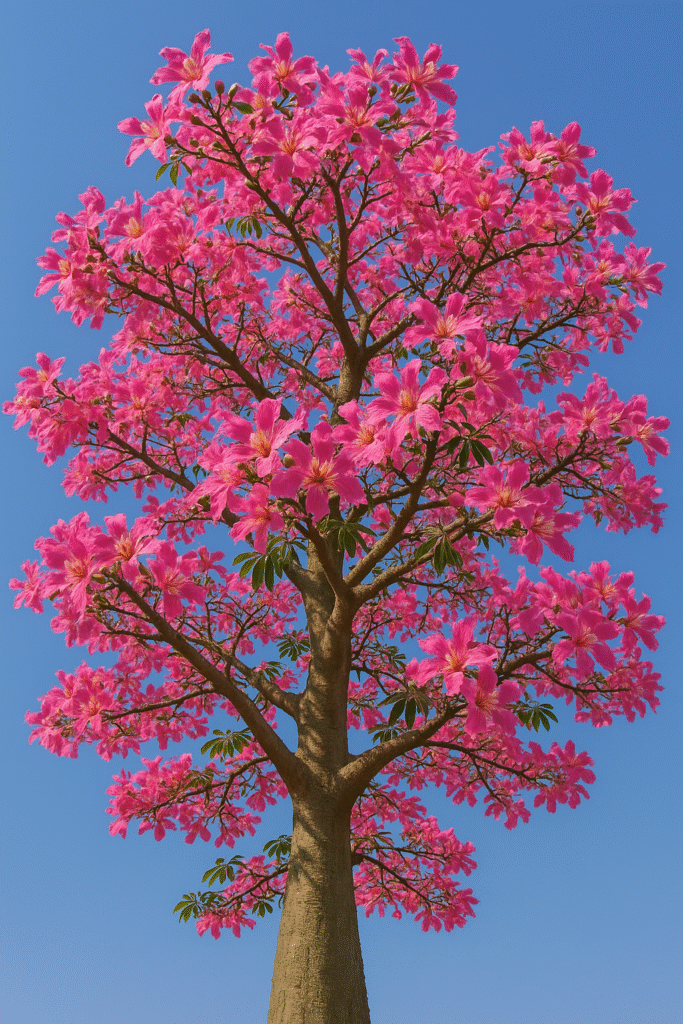The Silk Floss Tree (Ceiba speciosa), also known as the pink floss tree, kapok tree, or simply paineira in Brazil, is one of the most striking trees of South America. Native to Brazil, Argentina, Paraguay, Bolivia, and Uruguay, it captivates with its spectacular blooms and thick, spiny trunk. It’s a favorite in landscaping projects, urban green areas, and ecological restoration efforts thanks to its beauty and hardiness.
In this article, we’ll explore the characteristics, habitat, ecological value, and fascinating curiosities of this iconic tropical species.
Botanical Characteristics
The Silk Floss Tree is a large, deciduous tree that can reach 50 to 100 feet (15 to 30 meters) in height. Its most recognizable feature is the bottle-shaped trunk, often covered in conical spines that protect it from animals. The bark is green in young trees and darkens as the tree ages.
In fall and winter, the tree sheds its leaves and bursts into bloom with large, fragrant, pink flowers. Each flower has five petals, attracting pollinators like hummingbirds, bees, and butterflies. After flowering, the tree produces woody pods that open to release cotton-like fibers, called kapok, which surround the seeds and are carried by the wind.
Natural Habitat
The Silk Floss Tree thrives in tropical and subtropical climates with well-drained soils. It’s found in regions like the Atlantic Forest, Cerrado, and transitional zones between biomes. Due to its drought tolerance, it is also commonly planted in urban landscapes, including parks and along avenues.
The tree grows relatively fast and is resilient to pests and diseases, making it an ideal species for reforestation and land rehabilitation projects.
Ecological Importance
This tree plays a key role in the ecosystems where it grows. Its flowers provide abundant nectar and pollen for local pollinators during dry seasons, contributing to biodiversity conservation. The seeds and fruits serve as food for birds and small mammals.
Its broad canopy offers shade and shelter for other plants and animals, while its deep roots help prevent soil erosion and enhance water retention, making it an asset in climate-resilient landscapes.
Uses and Applications
Although its wood has little commercial value, the Silk Floss Tree offers a range of practical uses:
- Kapok fibers: Once commonly used for stuffing pillows, cushions, and mattresses. While less used today due to synthetic alternatives, natural kapok is still appreciated for its softness and sustainability.
- Urban landscaping: Thanks to its stunning blooms, it’s widely used in city parks, botanical gardens, and large open spaces.
- Environmental education: Its unique appearance and ecological role make it a great subject for nature awareness programs and school projects.
Fascinating Facts
- Symbol of resilience: Its ability to survive in dry, nutrient-poor soils has earned the tree a reputation as a symbol of adaptability and strength.
- Dramatic flowering: Often, the tree is completely leafless when it blooms, creating an impressive contrast between the bare branches and the vivid pink flowers.
- Water storage: The thick, swollen trunk serves as a natural water reservoir, helping the tree endure long dry seasons.
Planting and Care Tips
If you’re thinking of planting a Silk Floss Tree, be sure to consider the available space. Its roots are deep and expansive, so it should be planted away from sidewalks, buildings, and power lines. Also, its spiny trunk makes it unsuitable for play areas or paths with heavy foot traffic.
The tree prefers full sun and open areas. Young trees benefit from regular watering until well established, but once mature, they require minimal care and can tolerate harsh conditions.
Final Thoughts
The Silk Floss Tree is a breathtaking symbol of tropical beauty and ecological balance. With its striking flowers, strong ecological value, and adaptability, it deserves greater recognition and use in both urban and wild landscapes. Whether for aesthetic pleasure or environmental restoration, this tree is a gift from nature worth celebrating.

Stay dry and comfortable outdoors with the Amazon Basics Camping Tent. Featuring a 3-season dome design with rainfly, it’s perfect for camping trips, hiking adventures, and weekend getaways in nature.
Get Your Tent NowAdmire the cascading beauty of the Mysore Trumpet Vine. Discover how to grow and care for this exotic plant that drapes gracefully from above, adding a tropical touch to your space.
Read the Care Guide
